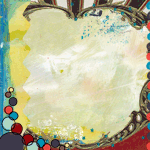This image is my re-imagining of Hope by George Frederick Watts.
This is one of the earliest of the great morality pictures by which Watts earned his fame. Describing these, he said, "All my pictures in the Tate Gallery are symbolical and for all time. Their symbolism is, however, more suggestive than worked out in detail." He goes on: "I want to make people think. My intention has not been so much to paint pictures that will charm the eye as to suggest great thoughts that will appeal to the imagination and the heart, and kindle all that is best and noblest in humanity."
"Hope" illustrates the power of these pictures to make peole think. The blinded figure, seated on the sphere with her broken lyre, is bending her ear to catch what music she may from the last remaining string. She cannot see the star shining above her; one by one the sweet notes of music have been taken from her, but still she sits, bowed but not broken, plucking with tender fingers whatever melody she may from the last string of those that gave her the full harmonies of beauty. She has no vision either of the star above or of the world of darkness and gloom below. Her attitude of dejection almost rejects the conventional idea that there is happiness to be found when everything seems lost, but the picture suggests the larger hope of the world that there is peace and light above the turmoil and sorrow of the earth.
From the book "Famous Paintings" printed in 1913.



































No comments:
Post a Comment